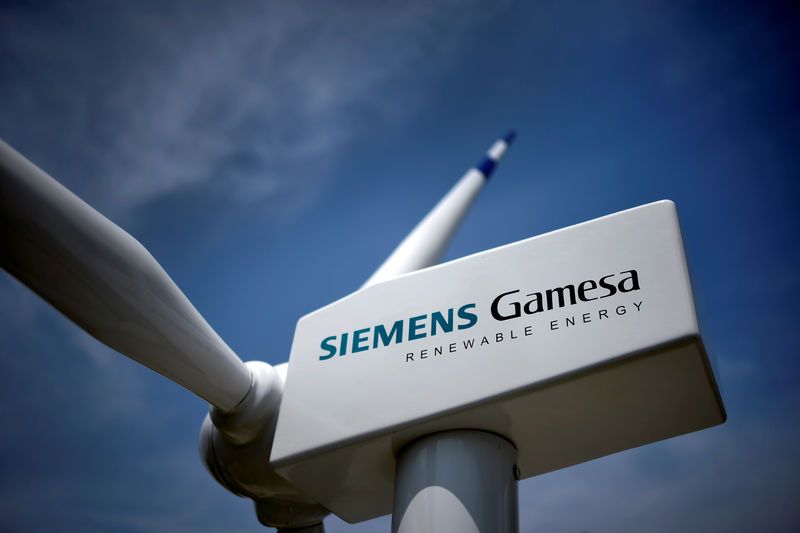By Christoph Steitz and Jose Elías Rodríguez
FRANKFURT/MADRID (Reuters) - Siemens Gamesa (MC:SGREN) has fallen behind biggest rival Vestas (CO:VWS) in the race for orders in the United States, hurt by a perceived lack of technology investment and a less centralized supply chain in the world's second-biggest wind turbine market.
The U.S. battleground is among the biggest for western turbine manufacturers, with the U.S. Energy Information Administration forecasting the addition of 6 gigawatts (GW) of capacity this year and a further 8 GW in 2018.
But things have not gone well for Siemens Gamesa since the merger that brought together Siemens' (DE:SIEGn) wind power division with rival Gamesa this year, even though it has described the United States as critical to its success.
The merger was aimed at giving the combined entity an edge in an increasingly competitive global market amid sector consolidation that saw Germany's Nordex (DE:NDXG) buy the turbine unit of Spain's Acciona (MC:ANA) and General Electric (N:GE) take over France's Alstom (PA:ALSO).
"Siemens Gamesa has struggled to bring an attractive turbine to North America," said one senior industry adviser who declined to be named to protect business relations.
There is a view that the company has not done enough to improve its geared turbines, the adviser added.
Siemens has mainly sold gearbox-based turbines in the United States, where they are the preferred model, but its market share has dwindled in recent years while that of Vestas has increased steadily.
TURBINE SWITCH?
Complementing its portfolio and recouping lost market share in the United States were among the main drivers of the tie-up with Gamesa, which has a broader offering of gearbox-based turbines and is expected to fare better locally.
Siemens Gamesa will present its new strategy in February and sources close to the group said chances are that the joint venture may use more of Gamesa's turbines in the United States in future.
"After the merger the combined company has greater scale in the U.S., which will enable us to increase the wind turbine models and the volumes produced in the country," Siemens Gamesa said in an e-mailed statement.
Improvement is badly needed after the group announced the closure of its blade production operation in Canada, job cuts at its nacelle manufacturing plant in Kansas and writedowns on the U.S. business that caused a profit warning and management reshuffle.
Siemens Gamesa did end a losing streak this week when it reported U.S. orders for 784 megawatts (MW) of capacity. It has also won an upgrade contract it says is worth 190 MW.
But that is still less than half of what has been taken in by Vestas. The Danish company's order book is brimming with 2,086 MW in announced U.S. deals, close to a third of its total orders globally.
Fresh data from the American Wind Energy Association (AWEA) also shows that Vestas is much more successful than Siemens Gamesa in striking deals for projects. The association's latest quarterly market report said Vestas has taken 47 percent of the U.S. wind projects under construction or in advanced development that have announced a supplier.
Siemens Gamesa's share stood at 8 percent, or 1,258 MW, at the end of the third quarter.
'PEDESTRIAN' OUTLOOK
"The need to catch up will keep a lid on stock momentum for at least another couple of quarters," Barclays (LON:BARC) analysts said, forecasting a "pedestrian" outlook for 2018, which they expect to be issued along with fourth-quarter results on Nov. 6.
Barclays expects next year's sales to be down by more than a fifth from its forecast for 2017 numbers. The analysts are forecasting sales of 8.48 billion euros ($9.88 billion) in 2018, well below the 10.14 billion Thomson Reuters I/B/E/S estimate.
In the medium term, the merger is expected to help Siemens Gamesa to gain a stronger foothold in the United States and recover some of this year's 30 percent lost market value -- a far cry from the 25 percent gain for shares in Vestas.
Regardless of the actual products, Siemens Gamesa must also find a way to compete with the centralized supply chain that Vestas has built in the United States.
Vestas operates four factories making towers, blades and nacelles in the state of Colorado, located in the middle of the windy central plains corridor of the United States, which analysts say is a big advantage.
"We think the key is localizing the product," said Chris Brown, president of Vestas's sales and service division in the United States and Canada.
Siemens Gamesa also has a strong presence in the region, with blade and nacelle production in Iowa and Kansas, though it does not identify the local providers from which it sources its towers. In the past it has bought towers from Broadwind Energy (O:BWEN), which has production sites in Wisconsin and Texas.
"In a cut-throat competitive turbine pricing environment, the additional costs of transport can win or lose contracts," said Jesse Broehl, senior analyst at Navigant Research.

($1 = 0.8584 euros)